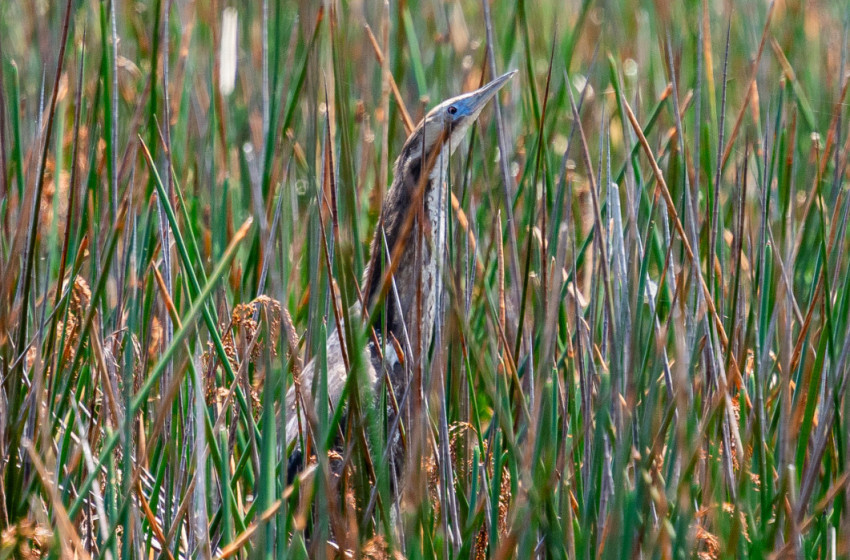Once Bittern twice shy – the mission to count the shy and secretive Australasian bittern
- 2/09/2024
- Maggie Tait

A large, secretive and shy, wetland heron – the Australasian bittern (matuku hūrepo) – isn’t easy to find which makes it hard to count them but a committed group has conducted a survey of the threatened birds in Northland.
The bittern monitoring project (Matuku Mahi) involving Kiwi Coast, the QEII National Trust, Northland Fish & Game Council, Department of Conservation, Northland Regional Council and partners, surveyed the nationally critical threatened species during breeding season last year.
The Department of Conservation estimates there are less than 1000 of the wetland birds remaining in Aotearoa and their numbers continue to decline due to habitat loss and predation. They forage in drains, flooded pasture and estuarine areas and feed on eels, fish, frogs, small birds, mice, lizards, kōura, molluscs and insects.
Despite its relatively large size – males can weigh up to 1.4 kgs and stand 74cm tall - very little is known about the surviving bittern populations in Northland.
“These birds are extremely secretive, and they also travel widely with a network of foraging and roosting habitats primarily in and around wetlands” said Craig Deal from Northland Fish and Game Council.
“That makes them hard to find but males are vocal during the breeding season and their booming mating call is distinctive.”
Between September and November 2023 acoustic recording devices were deployed in likely habitat around the Northland region and bittern presence was detected at 44 of the 78 sites surveyed.
“It was great to see bitterns had made four Fish & Game owned or managed wetlands their home. The Fish & Game wetlands are constructed wetlands, made and maintained primarily for game bird habitat and hunter access with funding from the sale of hunting and fishing licences.”
The highest number of bittern calls (1689 over an 8-day period) in a survey was recorded at Greenheart Wetland, a property managed by Northland Fish and Game and two other Northland Fish and Game wetlands were in the top ten locations with the most calls recorded (the Jack Bisset and Flaxmill Wetlands, both of which are QEII covenants).
QEII National Trust regional representative for the Whangārei region Nan Pullman said that including wetlands located on private land and protected by QEII covenants (an agreement between QEII and the landowner to protect land of ecological and cultural significance in perpetuity) had been useful in the survey.
“Bittern are particularly secretive and tend to frequent areas that are difficult to access, but we were able to identify some QEII covenants with likely habitats,” says Nan.
When told about the proposed survey, private landowners with QEII covenants were keen to be involved.
“It has been very rewarding for QEII to give individual landowners a chance to join this large, collaborative study,” she said.
Initial results from the first year of listening for the male bittern’s distinctive booming show that a number of QEII covenants are possible breeding sites.
Kiwi Coast spokesperson Ngaire Sullivan said the project aligns with similar national monitoring efforts being done by DOC and Love Bittern Trust.
“We’re helping landowners and communities find out where their bittern are foraging and roosting so we can help bring them back from the brink of extinction,” said Ngaire.
“The biggest threats to bittern survival have been drainage and destruction of wetland habitat, predation and the sedimentation of water which renders them unable to see prey in the water.”
Another survey would be done this coming spring.
“The information gained will be used to establish long-term monitoring sites and support management effort at key areas of bittern habitat.”
Other supporters of the research included the Royal Forest and Bird Society, Love Bittern Trust, The Shorebirds Trust as well as local hapū, community groups and farmers.
“It was great to see people from all walks of life so enthusiastic about protecting their local bittern, helping to put out recording devices and showing us where they thought bittern might be lurking.
“We all work so our Matuku Hūrepo can survive. If people are keen to get involved in the next Matuku Mahi survey beginning in September 2024, contact QEII, Fish and Game or Kiwi Coast to find out more.”
For more information including the 2023 Bittern Survey Report visit: https://kiwicoast.org.nz/bittern-matuku-hurepo/
Captions:
Bittern in QEII dune wetland covenant Ruakaka - Photo credit Kieran Pullman